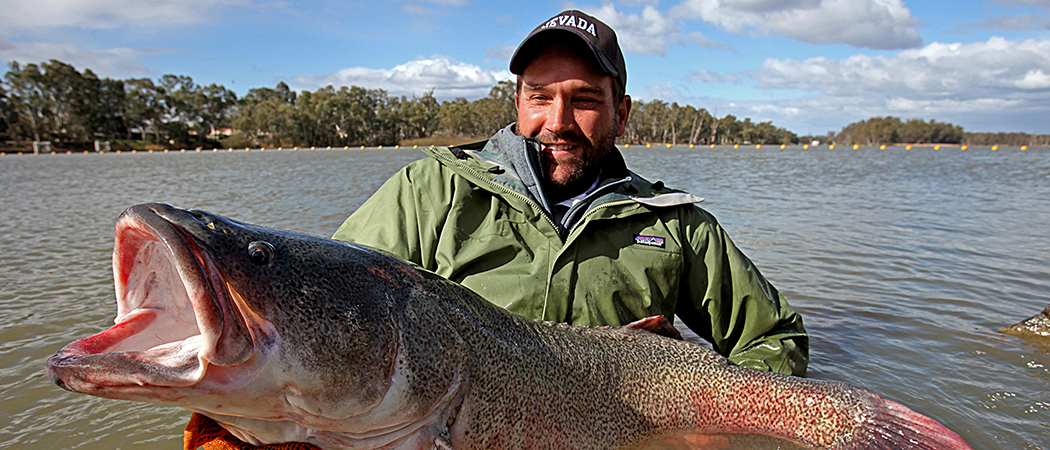A new National Geographic Museum exhibition, Monster Fish: In Search of the Last River Giants, features the work of the University of Nevada, Reno's research professor and host of the television show Monster Fish, Zeb Hogan. It opens March 26 at National Geographic's Washington D.C. headquarters and runs through Oct. 12, 2015.
"This fascinating exhibition is a trip around the world with one of Nat Geo's favorite explorers in search of bizarre and extraordinary species of freshwater fish," said National Geographic's vice president of Exhibitions, Kathryn Keane. "Zeb Hogan shows us that despite their size, these fish are an increasingly fragile link in some of the most important freshwater ecosystems on Earth."
Hogan is a National Geographic Fellow and faculty member of the University's biology department in the College of Science. He travels the globe finding, studying and protecting the world's largest freshwater fish - megafish like six-foot trout in Mongolia, rare spear-tooth freshwater sharks, huge wolf fish and electric eels or 14-foot-long stingrays in Thailand. He chronicles his travels on the Nat Geo WILD television show Monster Fish. Nearly 20 of the fish he studies and profiles on the show will be featured in the 6,000-square-foot interactive exhibition.
"The University's College of Science values scientific curiosity, discovery and ambition, and we encourage our students to see themselves as global citizens and our faculty to contribute solutions with global impact. Our educational partnership with the National Geographic Society for this exhibit is an ideal fit with these values," Jeff Thompson, dean of the College of Science said. "This endeavor will inspire young people to pursue interests, degrees and careers in the environmental sciences and contribute to a better understanding of the fragile health of fresh-water ecosystems around the world."
The museum exhibition, which will travel over the next five years to other museums around the United States, aims to educate visitors through the use of photos, videos, animations, interactives, sculpture, and text.
"After spending the last 20 years studying these elusive fish, I'm gratified to see that they are now the subject of a large scale museum exhibition," Hogan said. "It's my hope that this exhibition will reach millions of people, and increase awareness and appreciation for these often misunderstood and, in many cases imperiled, giants of the deep."
The Monster Fish exhibition takes visitors on a journey to river basins worldwide to learn about the awe-inspiring fish and the cultures and places that depend on them. The exhibition profiles the extraordinary biology and behaviors of these giant freshwater fish. It also offers the opportunity to investigate how scientists learn about these fish and develop solutions to save them.
With five impressive life-size sculptures, some as long as 20 feet, adrenaline-pumping video installations and hands-on interactives, Monster Fish is designed to appeal to a wide audience - from children and families to environmentalists and fishing enthusiasts. A gallery of aquariums with live fish, including juvenile alligator gar, will showcase healthy freshwater ecosystems from around the world.
"These are incredibly rare animals, which most people would never have a chance to see or appreciate - this exhibit is a window into an underwater world that few of us have ever experienced," Hogan said. "These animals can grow to over 20 feet in length, some living more than 100 years, and many are on the edge of extinction. The exhibition is the culmination of years of work by many people to find, study, and protect the world's largest freshwater fish."
As part of the exhibition opening, Hogan will talk about his search for freshwater giants at a National Geographic Live event the evening of March 26 and in a special student matinee that morning. An aquatic ecologist, he will share behind-the-scenes adventures and real "fish stories" from scientists he works with and the locals who live along the banks who help him find the big fish.
"Science is not our only tool for protecting these fish," he said. "Education and outreach are crucial too, because in many places I visit, endangered species conservation is a brand new concept that must be introduced and made relevant."
Hogan, who has a doctorate in ecology, has worked with nearly 100 scientists on the Monster Fish project, which spans six continents (North America, South America, Africa, Europe, Asia, and Australia) and encompasses several of Earth's most diverse freshwater ecosystems - ecological treasures - including World Heritage Sites, Ramsar Wetlands of International Importance and United Nations Environment Program Biodiversity Hotspots.











